Frontier
Religion
Preachers came to the area that would become Tennessee almost as soon as the first settlers moved there. Charlotte Robertson had a traveling preacher come and baptize her children in 1772/1773.
Charles Cummings started two congregations along the Holston River in 1772, only three years after William Bean settled there. Attacks by Indians were still a concern, so Cummings would ride his horse to religious services with a rifle across his shoulder.
Samuel Doak, a Presbyterian, was probably the first resident minister, coming to the state in 1777. He preached in several areas, and built the first church in the state at Salem in Washington County.
Doak later led about 100 riflemen from the area to the Battle of King’s Mountain during the Revolutionary War in 1780. Other preachers moved to the area so that by the time Tennessee became a state in 1796, there were 27 Presbyterian churches.
Baptists also came to the state in early years. They would establish a church even if they didn’t have a preacher. The first Baptist church was probably the one at Sinking Creek in Carter County, organized at a member’s home in 1775. By 1786, they had established the Holston Association, the first in the area.
Methodist preachers also moved into the state. The Methodist circuit rider was a preacher who rode wilderness roads to far-flung communities. The riders would hold religious services outside under the trees in warmer weather or at members’ homes in cold weather. Gradually they began to build chapels. For example, the Methodists built a stone building in Nashville in 1790, which was the first in the area.
While earlier French and Spanish explorers had brought Catholicism into the Tennessee region, Catholic churches were not built until after the frontier era. One of the first settlers in the area, Timothy Demonbreun, held Catholic services in his home. The first Catholic parish wasn’t established in the state until 1830.
African Americans gravitated toward Protestant Christianity as well. In fact, one slave, John Gloucester, proved to be a powerful preacher. A traveling Presbyterian minister, Gideon Blackburn, dis-cover-ed Gloucester’s talents, purchased his freedom, and enrolled him at Greeneville College. Gloucester and his family later moved to Philadelphia where he started the First African Presbyterian Church.
Great Revival
But even with all this activity, there still were large sections of the state that didn’t have access to organized religion. However, this was soon to change by a wave of religious activity later called the Great Revival.
By 1800, a new wave of evangelicalism, a “heartfelt” style of worship that began in camp meetings in Kentucky, changed Protestant religious practices. James McGready, a Presbyterian minister, was one of the major figures who spread camp style religious fervor throughout the area.
The emotional responses that accompanied the revival—weeping, falling into semi-consciousness, singing, jerking, and even dancing in the spirit—were called awakenings. The revivals spread across the state with crowds of several thousand people in attendance.
Even after the revival movement declined after 1805, people still held to their religious beliefs and churches increased in number.
Religious organizations in the state were also crucial in founding colleges. By 1800, there were two colleges associated with religions in East Tennessee, Washington College and Blount College, and one in Middle Tennessee, Davidson Academy. Shortly afterwards, Greeneville College and Tusculum College were established by two Presbyterian ministers. The two schools later merged and are now Tusculum College.
Picture Credits:
- A drawing showing a camp meeting during the early 1800s. The preacher is next to the building on the left while his audience is sitting on benches or standing in front of him. Tennessee State Museum
- A drawing of Samuel Doak based on a painting done of him. Tennessee State Library and Archives
- A print of Bishop Francis Ashbury. Tennessee State Museum
- A drawing of a frontier-era circuit rider holding an umbrella to ward off the rain. Circuit riders were preachers who traveled from community to community to hold religious services. Courtesy of The Granger Collection, New York
- An image of John Gloucester. Courtesy of the Library Company of Philadelphia
-
Photograph of the Samuel Doak House. This photo was released in 2009. It shows two wooden fences surrounding the home. Doak House Museum, Tusculum College
-
Drawing entitled, “Religious dancing of the Blacks termed ‘Shouting’.’’ This drawing was made in 1872 and included in the book, The black man of the South by Charles Stearns. It shows an African American man conducting a religious service. Two women are shown sitting while others sing and dance in a circle. New York Public Library
Frontier >> Living on the Frontier >> Everyday Life >> Religion
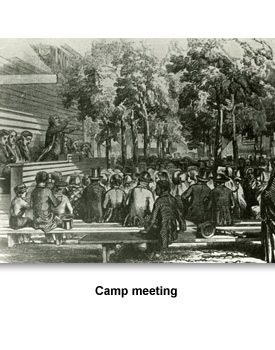
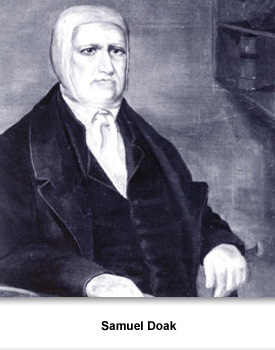
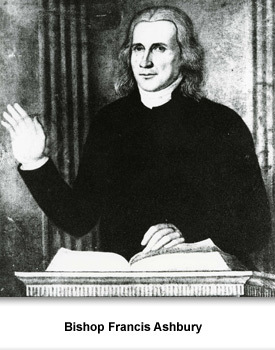
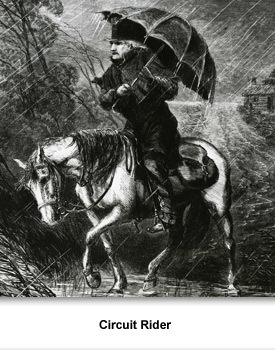
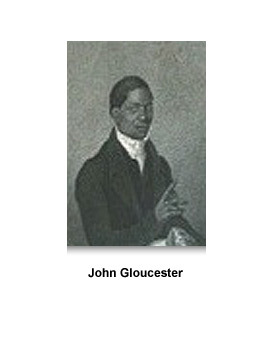
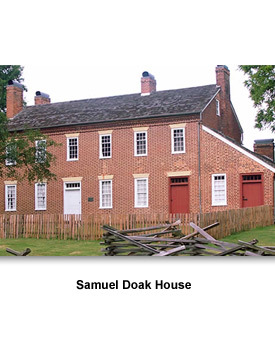
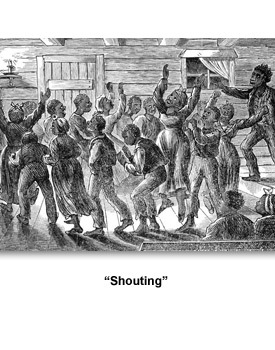
 Sponsored by: National Endowment for the Humanities
Sponsored by: National Endowment for the Humanities